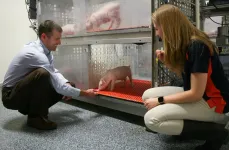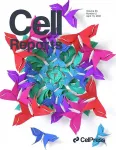(Press-News.org) HERSHEY, Pa. -- People who trust television and Facebook to provide them with accurate news about the coronavirus pandemic are less knowledgeable about COVID-19, according to a new study, which assessed people's knowledge of the virus in the earliest stages of the pandemic.
The study, published in the peer-reviewed journal Current Medical Research & Opinion, surveyed 5,948 adults in Pennsylvania between March 25-31, 2020, and found that those who relied on social media and TV for news were less likely to get the facts right about the coronavirus.
In fact, adults that used Facebook as an additional source of news in any way were less likely to answer COVID-19 questions correctly than those who did not.
"The rise of social media has changed the way people around the world keep up with current events, with studies showing that up to 66% of Americans rely on social media for news," said Dr. Robert Lennon, associate professor of family and community medicine at Penn State College of Medicine, one of the authors of the paper.
"This is worrying, as misinformation and misunderstanding about COVID-19 and how it spreads is likely to have fueled the pandemic, the death toll of which now surpasses 2.5 million worldwide." said Lennon.
In early March 2020, the COVID-19 outbreak had become alarming enough that Lennon and other Penn State researchers rapidly developed a survey to explore public knowledge, perceptions and preferred information sources regarding COVID-19. Within hours of being told that they had been awarded funding, the World Health Organization declared COVID-19 a pandemic, and two days later the president declared a national emergency.
The survey was disseminated to 5,948 adults in Pennsylvania, offering insight into the public use of information in the midst of a national emergency. The respondents answered questions about where they got their news about coronavirus from, and which news sources they trusted most. They were then given 15 statements about COVID-19 and asked if they thought the statements were true or false, and how confident they were in their answer.
The questions covered knowledge across several domains -- transmission, severity, treatment - and asked questions felt to be of easy, moderate and hard difficulty in each. As media coverage of COVID-19 escalated, developing knowledge questions became increasingly difficult -- a nearly impossible question on Monday was by Thursday so easy it couldn't be used.
The results showed that the most trusted news sources were government websites (42.8%), followed by television (27.2%) and health system communications (9.3%).
There was a clear relationship between where people got their news from and their knowledge of coronavirus. For example, participants who said that their most trusted source of information was government health websites were more likely to correctly answer COVID-19 questions than other groups. On the other hand, individuals whose most trusted source was television news were less likely to correctly answer COVID-19 questions than other groups. Respondents who selected "Facebook" as either their single most trusted source or as an additional information source were less likely to answer knowledge questions correctly.
The findings highlight the importance of considering where people get their news from when designing public health interventions. Guidance such as "stay at home," "wash your hands," "wear a mask" and "socially distance" are only effective if understood and followed.
"Effective communication is a critical element of successfully managing a pandemic response," said Lennon. "Until vaccination is widespread and proven to be effective, public compliance with public health recommendations is our best chance of containing the disease."
"The first step in compliance is an understanding of those recommendations, so it is vital that health communicators -- such as those working for government agencies, academic institutions and health care organizations -- consider how the public get their information and monitor these venues to correct misinformation when it appears."
INFORMATION:
Surav Sakya, Lauren Van Scoy, John Garman, Erin Miller, Bethany Snyder, Emily Wasserman and Vernon Chinchilli of Penn State College of Medicine also contributed to this research.
This research was supported by Penn State Huck Institutes of the Life Sciences, Penn State Social Science Research Institute and the Department of Family and Community Medicine at Penn State College of Medicine. Family and Community Medicine faculty were involved in study design and manuscript production. The researchers disclose no other conflicts of interest.
The REDCap database used in this project was funded by Penn State Clinical and Translational Science Institute through the National Centers for Advancing Translational Science (Grant number UL1 TR002014).
URBANA, Ill. - Before humans can benefit from new drug therapies and nutritional additives, scientists test their safety and efficacy in animals, typically mice and rats. But, as much as they've done for biomedical research, rodents aren't always the best research model for studies on neonatal brain development and nutrition. That's where pigs can play an important role.
University of Illinois researchers say the domestic pig is ideal for these studies because their brain size, rate of development, and digestive system are excellent analogues for human newborns.
They know a lot about pig brains, having built the first - and recently, the second - complete, MRI-based atlases of the organ. They've used the first to study ...
La Jolla, CA--The human genome contains the instructions to make tens of thousands of proteins. Each protein folds into a precise shape--and biologists are taught that defined shape dictates the protein's destined function. Tens of thousands of singular shapes drive the tens of thousands of needed functions.
In a new Cell Reports study, researchers at La Jolla Institute for Immunology demonstrate how Ebola virus has found a different way to get things done. The virus encodes only eight proteins but requires dozens of functions in its lifecycle. ...
New research by a team at Resources for the Future (RFF) has found that at least 27% of new pests in the United States were initially detected by members of the general public. The study, which was published today in the journal Conservation Science and Practice, seeks to understand who is identifying new invasive species that make their way into the United States.
The RFF team developed and analyzed a new dataset of pest discoveries in the United States, using a sample size of 169 detections from 2010 to 2018. Researchers divided discovery sources into three categories: government agencies, local extension specialists and researchers, and members of the public, with the latter category including community ...
ITHACA, N.Y. - Just as humans are challenged from the social isolation caused by the coronavirus pandemic, a new study finds that a solitary lifestyle has profound effects on the brains of a social insect: paper wasps.
Paper wasps recognize the brightly colored faces of other paper wasps, an ability they lose when reared in isolation. The wasps' ability to remember faces is similar to primates and humans, but unlike other social insects.
The study revealed that when adult wasps are housed in solitude, visual areas of their brains - especially those involved with identifying nuanced color patterns and shapes - are smaller and less developed ...
Researchers from the HSE Center for Language and Brain https://www.hse.ru/en/neuroling/ have, for the first time, described the language abilities of Russian children with Autism Spectrum Disorder (ASD) at all linguistic levels (e.g., phonology, lexicon, morphosyntax, and discourse), using a language test that takes into account the psycholinguistic variables most relevant for Russians. The study was published in Journal of Autism and Developmental Disorders.
In 2020, the US Centers for Disease Control and Prevention reported that one in every 54 children in the country is diagnosed with ASD. Usually, ...
Ultralight bosons are hypothetical particles whose mass is predicted to be less than a billionth the mass of an electron. They interact relatively little with their surroundings and have thus far eluded searches to confirm their existence. If they exist, ultralight bosons such as axions would likely be a form of dark matter, the mysterious, invisible stuff that makes up 85 percent of the matter in the universe.
Now, physicists at MIT's LIGO Laboratory have searched for ultralight bosons using black holes -- objects that are mind-bending orders of magnitude ...
Little is known about azhdarchid pterosaurs, gigantic flying reptiles with impressive wingspans of up to 12 meters. Cousins of dinosaurs and the largest animals ever to fly, they first appeared in the fossil record in the Late Triassic about 225 million years ago and disappeared again at the end of the Cretaceous period about 66 million years ago. One of their most notable features for such a large flighted animal was a neck longer than that of a giraffe. Now, researchers report an unexpected discovery in the journal iScience on April 14: their thin neck vertebrae got their strength from an intricate internal structure unlike anything ...
Describing the genetic diversity of human populations is essential to improve our understanding of human diseases and their geographical distribution. However, the vast majority of genetic studies have been focused on populations of European ancestry, which represent only 16% of the global population. Scientists at the Institut Pasteur, Collège de France, and CNRS have looked at understudied human populations from the South Pacific, which are severely affected by a variety of diseases, including vector-borne infectious diseases such as Zika virus, dengue, and chikungunya, and metabolic diseases such as obesity and diabetes. Using genome sequencing of ...
In physics, things exist in "phases", such as solid, liquid, gas. When something crosses from one phase to another, we talk about a "phase transition" - think about water boiling into steam, turning from liquid to gas.
In our kitchens water boils at 100oC, and its density changes dramatically, making a discontinuous jump from liquid to gas. However, if we turn up the pressure, the boiling point of water also increases, until a pressure of 221 atmospheres where it boils at 374oC. Here, something strange happens: the liquid and gas merge into a single phase. Above this ...
Bruising caused by physical abuse is the most common injury to be overlooked or misdiagnosed as non-abusive before an abuse-related fatality or near-fatality in a young child. A refined and validated bruising clinical decision rule (BCDR), called TEN-4-FACESp, which specifies body regions on which bruising is likely due to abuse for infants and young children, may improve earlier recognition of cases that should be further evaluated for child abuse. Findings were published in the journal JAMA Network Open.
"Bruising on a young child is often dismissed as a minor injury, but depending on where the bruise appears, it can ...


